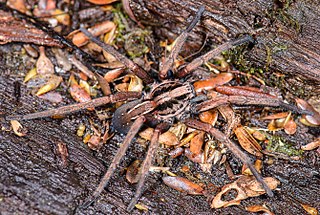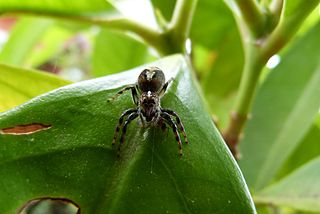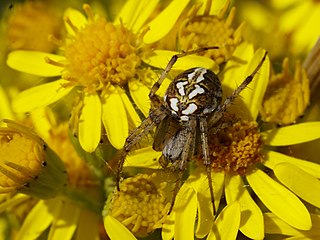
Miturgidae is a family of araneomorph spiders that includes nearly 170 species in 29 genera worldwide. First described by Eugène Simon in 1886, it has been substantially revised, and includes the previous family Zoridae as a synonym, and excludes the family Xenoctenidae. Several genera have also been removed, such as the large genus Cheiracanthium, which was transferred to the Cheiracanthiidae.

Wandering spiders (Ctenidae) are a family of spiders that includes the Brazilian wandering spiders. These spiders have a distinctive longitudinal groove on the top-rear of their oval carapace similar to those of the Amaurobiidae. They are highly defensive and venomous nocturnal hunters. Despite their notoriety for being dangerous, only a few members of Phoneutria have venom known to be hazardous to humans, but the venoms of this family are poorly known, so all larger ctenids should be treated with caution.

Zoropsidae, also known as false wolf spiders for their physical similarity to wolf spiders, is a family of cribellate araneomorph spiders first described by Philipp Bertkau in 1882. They can be distinguished from wolf spiders by their two rows of eyes that are more equal in size than those of Lycosidae.

Amycus is a genus of jumping spiders that was first described by Carl Ludwig Koch in 1846.

Breda is a genus of jumping spiders that was first described by George Peckham & Elizabeth Peckham in 1894.

Cocalus is a genus of jumping spiders that was first described by Carl Ludwig Koch in 1846, and is named after Cocalus, a Sicilian king of Greek mythology.

Dendryphantes is a genus of jumping spiders that was first described by Carl Ludwig Koch in 1837.

Euophrys is a genus of jumping spiders that was first described by Carl Ludwig Koch in 1834. The small black E. omnisuperstes lives on Mount Everest at elevations up to 6,700 meters, possibly making it the most elevated animal in the world.

Frigga is a genus of jumping spiders that was first described by Carl Ludwig Koch in 1850. The name is derived from Frigga, a Norse goddess.

Plexippus is a genus of jumping spiders that was first described by Carl Ludwig Koch in 1846. It is considered a senior synonym of Hissarinus and Apamamia.

Neoscona, known as spotted orb-weavers and barn spiders, is a genus of orb-weaver spiders (Araneidae) first described by Eugène Simon in 1895 to separate these from other araneids in the now obsolete genus Epeira. The name Neoscona was derived from the Greek νέω, meaning "spin", and σχοῐνος, meaning "reed" They have a mostly pantropical distribution and one species, Neoscona adianta, has a palearctic distribution. As of April 2019 there are eight species that can be found in the United States and Canada:

Tetragnatha is a genus of long-jawed orb-weavers found all over the world. It was first described by Pierre André Latreille in 1804, and it contains hundreds of species. Most occur in the tropics and subtropics, and many can run over water. They are commonly called stretch spiders in reference to their elongated body form and their ability to hide on blades of grass or similar elongated substrates by stretching their front legs forward and the others behind them. The name Tetragnatha is derived from Greek, tetra- a numerical prefix referring to four and gnatha meaning "jaw". Evolution to cursorial behavior occurred long ago in a few different species, the most studied being those found on the Hawaiian islands. One of the biggest and most common species is T. extensa, which has a holarctic distribution. It can be found near lakes, river banks or swamps. Large numbers of individuals can often be found in reeds, tall grass, and around minor trees and shrubs.

Zelotes is a genus of ground spiders that was first described by J. Gistel in 1848.

Antrodiaetus is a genus of American and Japanese folding trapdoor spiders first described by Anton Ausserer in 1871. The name is a combination of the Greek "antrodiaitos" (αντροδιαιτος), meaning "living in caves", "antron" (αντρον), meaning "cave", and "diaita (διαιτα), meaning "way of life, dwelling".

Gnaphosa is a genus of ground spiders that was first described by Pierre André Latreille in 1804. They all have a serrated keel on the retromargin of each chelicera.

Micaria is a genus of ground spiders that was first described by Niklas Westring in 1851. They are 1.3 to 6.5 millimetres long.
Creugas is a genus of corinnid sac spiders first described by Tamerlan Thorell in 1878.

Cycloctenus is a genus of Australasian araneomorph spiders in the family Cycloctenidae, first described by L. Koch in 1878. Originally placed with the nursery web spiders, it was transferred to the family Toxopidae because of the distinctive arrangement of its eyes, particularly the enlarged posterolateral eyes. It was moved to the Cycloctenidae in 1967.

Trachyzelotes is a genus of ground spiders that was first described by H. Lohmander in 1944 as a subgenus of Zelotes, and was raised to genus status in 1967. It has a body length of 3 to 13 millimetres.

















